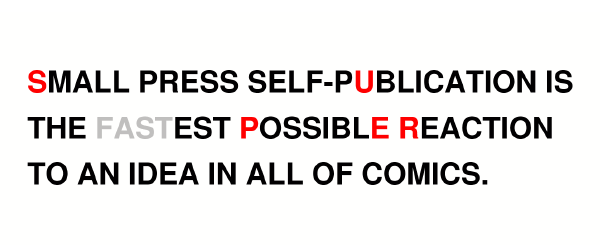El boom del Internet como solución para reducir las barreras entre emisor y receptor a velocidades infinitesimales impactó sobremanera en el mundo del comic en los inicios del siglo XXI. Los famosos webcomics marcan un parteaguas en la forma en la que voces nuevas se hacen escuchar en esta industria, con numerosos casos en donde sus esfuerzos se ven recompensados al dar el salto hacia las casas editoriales comerciales e independientes.
El autor multimedia Warren Ellis, siendo un estudioso del comic y el ambiente que lo rodea, analiza este trend que se ha convertido ya en un hábito que llegó para quedarse, encontrando analogías y diferencias marcadas con lo que en antaño se hacía para difundir al Noveno Arte de una forma inmediata, a bajo precio y con material novedoso una y otra vez.
– – – – – – – – – –
SUPERFAST
© Warren Ellis
Back when dinosaurs ruled the earth etc etc, the British small press movement was based around the Fast Fiction stand at the Westminster Comic Marts. The Comic Marts were supermini convention dealer’s rooms, basically, held once every two months.
Fast Fiction was a mail-order clearing house for small press publications.
The Fast Fiction stand at the Marts sold small press comics. Allcomers.
They took a percentage of sales to pay for the table. So a great many peoples’ production time was based around the Marts. You’d have something out every two months. It became the absolute focus of the British small press movement. They called it Fast Fiction because that’s what they were selling, as far as they were concerned.
Small press self-publication is the fastest possible reaction to an idea in all of comics. You have the idea, you make it, you print it, you get it out there. The vast majority of comics Fast Fiction handled were whacked out on photocopiers the week before the Mart.
If I have an idea for a comic right now, the chances are that the earliest you’ll see it is eight months from now. Maybe. Takes a year for a Vertigo comic to go from pitch to publication.
If you have an idea right now, you could complete it to the same level of finish and have it out two months from now. Can take a matter of days to do a minicomic (or a “stripzine”, as they were called, back in the Dark Ages here).
The aesthetic is similar to a band turning an idea into a cassette or a CD in days. Fast Fiction.
Here we are, nigh on twenty years laters, and there are other options available. There’s desktop publishing and printers. There’s floppy disks and CD burners. There’s cheap home photocopiers. And, of course, there’s the Web. I could do a 12-page comic in a day, scan the bastard and have it broadcast before I went to bed. (I’m not going to, but the point is, I could if I felt like it).
That’s beyond fast fiction. That’s Superfast.
Superfast is primarily the speed from completion to broadcast. If you feel like being punk about it, it can also be the completion time itself. There have been a few fun pieces that were whacked out while the idea was still hot, that still communicate the idea clearly despite the rawness of execution. But in giving yourself something as a deadline — which is what I think of when I think of Fast Fiction — or in knowing that you can get it on the web and in front of the world within moments of the piece’s completion… that’s what I think of as Superfast.
– – – – – – – – – –
Completamente a salvo del célebre colapso del dot com, los comics encontraron en la supercarretera de la información una plataforma viable como canal de distribución, la cual sigue vigente y sin signos de obsolescencia. La transmisión de nuevo contenido a cada instante por más y más entusiastas en el arte secuencial es impresionante, dando por sentado que tanto el medio impreso como el digital pueden convivir en armonía sin peligro de canibalizarse uno con otro.


